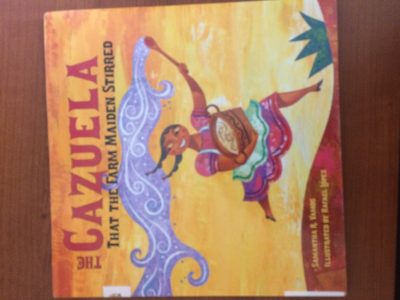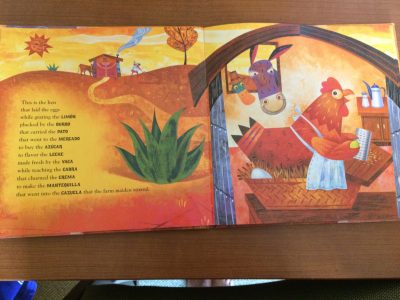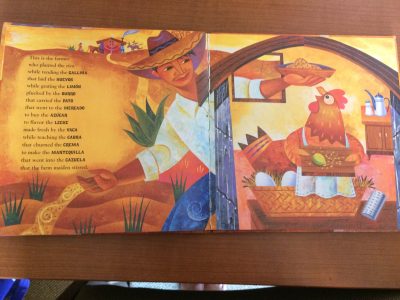The Cazuela that the Farm Maiden Stirred
Written by Samantha R. Vamos
Illustrated by Rafael Lopez
Charlesbridge, 2011
28 pages, Nursery Rhyme
In The Cazuela that the Farm Maiden Stirred, children can follow along with the process of making a dish using vocabulary words in both Spanish and English. In this take on the nursery rhyme “The House that Jack Built,” a farm maiden gets help with making arroz con leche, or rice pudding, from farm animals and the farmer as the narrator goes through the process of making the dish, repeating all the parts of the process. The introduction of Spanish words comes after the introduction of the process in English. That way, children can understand that the words in Spanish replace the words in English from the previous page. The Spanish vocabulary words remain on each of the following pages and are bolded to emphasize the change.
Because this book intends to incorporate Spanish vocabulary into the book, the plot is secondary to the vocabulary words. This book serves as a window to children who do not know Spanish vocabulary or are not familiar with cooking while living on a farm; as Samantha R. Vamos writes, she came up with the idea for The Cazuela that the Farm Maiden Stirred when she thought about asking a neighbor for milk and eggs, and then thought that if she lived on a farm, she could ask the animals for milk and eggs. The text also serves as a mirror for students who are familiar with the Spanish language or who live in a rural area and might use help from their “neighbors” as the farm maiden did. Because the Spanish vocabulary words are incorporated into the English text, this book would be perfect in a bilingual classroom, or for English language learners to practice. I could also see a secondary Spanish teacher using the text and asking students to flip it—to write the text in Spanish and slowly incorporate English vocabulary words. Although there is not a huge social justice action associated with this text, because of the recipe at the end of the story, the text can serve as a door if students want to make the arroz con leche like the farm maiden and her friends.
Pura Belpré Award-winning artist Rafael López illustrated this text using acrylics on grained wood. López used primarily warm colors in his paintings, but he used some blues and greens for accent colors. The emphasis on warm colors can help younger children realize that the location of the story is somewhere very warm. López also drew the animals about the same size as the humans as a way to show that their involvement in the cooking process was vital to the dish’s success. In this respect, the illustrations mirror the text and do not add or contradict Vamos’ words.
The Cazuela that the Farm Maiden Stirred was nominated for a Monarch Award in 2013 and received the Pura Belpré Illustration Honor in 2012. The last three pages of the text feature a recipe for arroz con leche and a glossary of Spanish terms used in the text.



